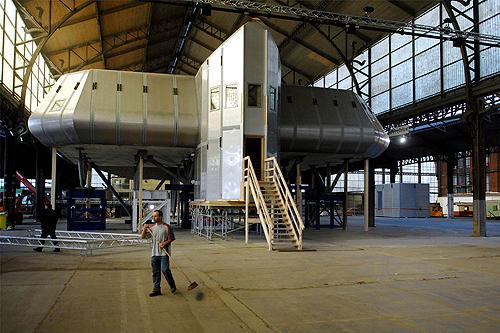New polar station to conduct environment-friendly research

A worker cleans the ground in front of the Princess Elisabeth polar science station during a presentation of the project by the International Polar Foundation in Brussels, Belgium on Wednesday. The Princess Elisabeth station will be a totally energy self- THE ASSOCIATED PRESS, GEERT VANDEN WINJNGAERT
Sep 6, 2007
Last updated on May 12, 2016 at 03:24 p.m.
BRUSSELS, Belgium – The Belgian-based International Polar Foundation on Wednesday unveiled what it claimed to be the world’s first zero-emissions polar science station in Antarctica to research climate change.
The Princess Elisabeth station will be an energy self-sufficient research base that will allow scientists to study the impact of climate change in one of the world’s most inhospitable environments without leaving a big polluting mark, scientists said.
“This base will be the first of its kind to produce zero emissions, making it a unique model of how energy should be used in the Antarctic,” said Belgian polar explorer Alain Hubert, who helped found the foundation, which researches the impact of climate changes on polar caps.
Research at the base would focus on the analysis of the deep ice shelves, he said. Scientists use the shelves to record global climate conditions.
Get The Daily Illini in your inbox!
Johan Berte, who leads the station design team and manages the project, said the station could be a blueprint for future stations in Antarctica, where strict guidelines demand that scientists do as much as they can to prevent pollution. Older and existing stations are powered by costly and environmentally damaging fuel shipments.
The Princess Elisabeth’s roof will be covered by solar panels, designed to provide the bulk of energy needed to run the isolated post. Other energy sources will come from large wind turbines.
Scientists behind the station, which is expected to have a lifespan of 25 years, aim to conduct research in climatology, glaciology and microbiology. The Belgian government will contribute funding to the public-private project.
Parts of the $16.3 million, prefabricated station are expected to reach the Antarctic northeastern coastline by Dec. 25 and then will be hauled, piece by piece, onto the 60- to 90-foot-high ice shelf and some 124 miles inland, where it will be rebuilt and become home to 20 scientists from November to February.
The station will be nestled on a ridge a few miles north of the Soer Rondane Mountains, and will form part of a network of stations with Russia and Japan, which have stations nearby.
“The biggest challenge will be to unload on the Antarctic continent,” Berte said.
The station project is part of International Polar Year, a global initiative involving more than 50,000 researchers studying how global warming and other phenomena are changing the coldest parts of the Earth and how this impacts the rest of the world.
The initiative is the largest of its type for 50 years, unifying scientists from 63 nations in 228 studies to monitor the health of the polar regions, using icebreakers, satellites, stations and submarines.





